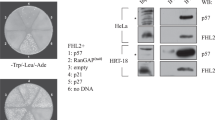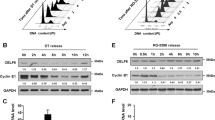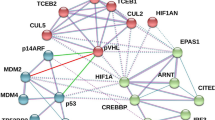Abstract
The newly identified p53-related gene, p73, encodes a nuclear transcription factor. Unlike p53, p73 has various isoforms with different NH2- and COOH-terminal tails. p73α with the longest COOH-terminal extension is most abundantly expressed in many tissues and cells among those splicing isoforms of p73 and the COOH-terminal region appears to have an autoregulatory function. To isolate and characterize the cellular protein(s) that interacts with the unique COOH-terminal region of p73α, we employed a yeast two-hybrid screen with a human fetal brain and 293 cell cDNA libraries. We identified the receptor for activated C kinase (RACK1) as a new member of p73α-binding proteins. The interaction was confirmed by coimmunoprecipitation experiments, whereas RACK1 did not interact with p53 or p73β. Ectopic overexpression of RACK1 in SAOS-2 cells reduced the p73α-mediated transcription from the p53/p73-responsive promoters, and inhibited the p73α-dependent apoptosis. On the other hand, the p53-dependent transcriptional activation as well as apoptosis was unaffected in the presence of RACK1. Furthermore, we found that pRB physically bound to RACK1, and repressed the RACK1-dependent inhibition of p73α. Taken together, our observations suggest that pRB diminishes the RACK1-mediated inhibition of p73α activity through the interaction with RACK1.
This is a preview of subscription content, access via your institution
Access options
Subscribe to this journal
Receive 50 print issues and online access
$259.00 per year
only $5.18 per issue
Buy this article
- Purchase on Springer Link
- Instant access to full article PDF
Prices may be subject to local taxes which are calculated during checkout







Similar content being viewed by others
References
Baumann M, Gires O, Kolch W, Mischak H, Zeidler R, Pich D and Hammerschmidt W . (2000). Eur. J. Biochem., 267, 3891–3901.
Chang BY, Chiang M and Cartwright CA . (2001). J. Biol. Chem., 276, 20346–20356.
Chen CL, Ip SM, Cheng D, Wong LC and Ngan HY . (2000). Clin. Cancer Res., 6, 3910–3915.
Crook T, Marston NJ, Sara EA and Vousden KH . (1994). Cell, 79, 817–827.
De Laurenzi V, Costanzo A, Barcaroli D, Torrinoni A, Falclco M, Annicchiarico-Petruzzelli M, Levrero M and Melino G . (1998). J. Exp. Med., 188, 1763–1768.
De Laurenzi V, Catanl MV, Teminoni A, Corazzari M, Melino G, Costanzo A, Levrero M and Knight RA . (1999). Cell Death Differ., 6, 389–390.
De Laurenzi V, Raschella G, Barcaroli D, Annicchiarico-Petruzzelli M, Ranalli M, Catani MV, Tanno B, Costanzo A, Levrero M and Melino G . (2000). J. Biol. Chem., 275, 15226–15231.
Di Como CJ, Gaiddon C and Prives C . (1999). Mol. Cell. Biol., 19, 1438–1449.
Fang L, Lee SW and Aaronson SA . (1999). J. Cell Biol., 147, 823–830.
Fontemaggi G, Gurtner A, Strano S, Higashi Y, Sacchi A, Piaggio G and Blandino G . (2001). Mol. Cell. Biol., 21, 8461–8470.
Geijsen N, Spaargaren M, Raaijmakers JAM, Lammers JWJ, Koenderman L and Coffer PJ . (1999). Oncogene, 18, 5126–5130.
Giaccia AJ and Kastan MB . (1998). Genes Dev., 12, 2973–2983.
Gostissa M, Hengstermann A, Fogal V, Sandy P, Schwartz SE, Scheffner M and Sal GD . (1999). EMBO J., 18, 6462–6471.
Grob TJ, Novak U, Maisse C, Barcaroli D, Luthi AU, Pirnia F, Hugli B, Graber HU, De Laurenzi V, Fey MF, Melino G and Tobler A . (2001). Cell Death Differ., 8, 1213–1223.
Gu W and Roeder RG . (1997). Cell, 90, 595–606.
Hollstein M, Sidransky D, Vogelstein B and Harris CC . (1991). Science, 253, 49–53.
Hupp TR, Meek DW, Midgley CA and Lane DP . (1992). Cell, 71, 875–886.
Ikawa S, Nakagawara A and Ikawa Y . (1999). Cell Death Differ., 6, 1154–1161.
Irwin M, Marin MC, Phillips AC, Seelan RS, Smith DI, Liu W, Flores ER, Tsai KY, Jacks T, Vousden KH and Kaelin Jr WG . (2000). Nature, 407, 645–648.
Jayaraman L, Murthy KGK, Zhu C, Curran T, Xanthoudakis S and Prives C . (1997). Genes Dev., 11, 558–570.
Jost CA, Marin MC and Kaelin Jr WG . (1997). Nature, 389, 191–194.
Kaghad M, Bonnet H, Yang A, Creancier L, Biscan JC, Valent A, Minty A, Chalon P, Lelias JM, Dumont X, Ferrara P, McKeon F and Caput D . (1997). Cell, 90, 809–819.
Ko LJ and Prives C . (1996). Genes Dev., 10, 1054–1072.
Kwek SSS, Derry J, Tyner AL, Shen Z and Gudkov AV . (2001). Oncogene, 20, 2587–2599.
Levine AJ, Perry ME, Chang A, Silver A, Dittmer D, Wu M and Welsh D . (1994). Br. J. Cancer, 69, 409–416.
Levine AJ . (1997). Cell, 88, 323–331.
Liliental J and Chang DD . (1998). J. Biol. Chem., 273, 2379–2383.
Lissy NA, Davis PK, Irwin M, Kaelin Jr WG and Dowdy SF . (2000). Nature, 407, 642–645.
Mcleod M, Shor B, Caporaso A, Wang W, Chen H and Hu L . (2000). Mol. Cell. Biol., 20, 4016–4027.
Minty A, Dumont X, Kaghad M and Caput D . (2000). J. Biol. Chem., 275, 36316–36323.
Mochly Rosen D . (1995). Science, 268, 247–251.
Nakagawa T, Takahashi M, Ozaki T, Watanabe K, Todo S, Mizuguchi H, Hayakawa T and Nakagawara A . (2002). Mol. Cell. Biol., 22, 2575–2585.
Oren M . (1994). Cancer Biol., 5, 221–227.
Ozaki T, Naka M, Takada N, Tada M, Sakiyama S and Nakagawara A . (1999). Cancer Res., 59, 5902–5907.
Pietenpol JA, Tokino T, Thiagalingam S, El-Deiry W, Kinzler KW and Vogelstein B . (1994). Proc. Natl. Acad. Sci. USA, 91, 1998–2002.
Pozniak CD, Radinovic S, Yang A, McKeon F, Kaplan DR and Miller FD . (2000). Science, 289, 304–306.
Prives C and Hall P . (1999). J. Pathol., 187, 112–126.
Qin X-Q, Chittenden T., Livingston DM and Kaelin Jr WG . (1992). Genes Dev., 6, 953–964.
Rodriguez MS, Desterro JMP, Lain S, Midgley CA, Lane DP, Hay RT . (1999). EMBO J., 18, 6455–6461.
Ron D, Chen CH, Caldwell J, Jamieson L, Orr E and, Mochly Rosen D . (1994). Proc. Natl. Acad. Sci. USA, 91, 839–843.
Ron D and Mochly Rosen D . (1995). Proc. Natl. Acad. Sci. USA, 92, 492–496.
Ron D, Luo J and Mochly Rosen D . (1995). J. Biol. Chem., 270, 24180–24187.
Sang N, Severino A, Russo P, Baldi A, Giordano A, Mileo AM, Paggi MG and De Luca A . (2001). J. Biol. Chem., 276, 27026–27033.
Shaw P, Freeman J, Bovey R and Iggo R . (1996). Oncogene, 12, 921–930.
Springer TA . (1994). Cell, 76, 301–314.
Steegenga WT, Shvarts A, Riteco N, Bos JL and Jochemsen AG . (1999). Mol. Cell. Biol., 19, 3885–3894.
Stiewe T and Putzer BM . (2000). Nat. Genet., 26, 464–469.
Strano S, Munarriz E, Rossi M, Castagnoli L, Shaul Y, Sacchi A, Oren M, Sudol M, Cesareni G and Blandino G . (2001). J. Biol. Chem., 276, 15164–15173.
Takenaka I, Morin F, Seizinger BR and Kley N . (1995). J. Biol. Chem., 270, 5405–5411.
Ueda Y, Hijikata M, Takagi S, Chiba T and Shimotohno K . (1999). Oncogene, 18, 4993–4998.
Wang Y and Prives C . (1995). Nature, 376, 88–91.
Watanabe K, Ozaki T, Nakagawa T, Miyazaki K, Takahashi M, Hosoda M, Hayashi S, Todo S and Nakagawara A . (2002). J. Biol. Chem., 277, 15113–15123.
Waterman MJF, Stavridi ES, Waterman JLF and Halazonetis TD . (1998). Nat. Genet., 19, 175–178.
Yang A, Walker N, Bronson R, Kaghad M, Oosterwegel M, Bonnin J, Vagner C, Bonnet H, Dikkes P, Sharpe A, McKeon F and Caput D . (2000). Nature, 404, 99–103.
Yarwood SJ, Steele MR, Scotland G, Houslay MD and Bolger GB . (1999). J. Biol. Chem., 274, 14909–14917.
Zaika AI, Kovalev S, Marchenko N and Moll UM . (1999). Cancer Res., 59, 3257–3263.
Zaika A, Irwin M, Sansome C and Moll UM . (2001). J. Biol. Chem., 276, 11310–11316.
Zeng X, Chen L, Jost CA, Maya R, Keller D, Wang X, Kaelin Jr WG, Oren M, Chen J and Lu H . (1999). Mol. Cell. Biol., 19, 3257–3266.
Zeng X, Li X, Miller A, Yuan Z, Yuan W, Kwok RP, Goodman R and Lu H . (2000). Mol. Cell. Biol., 20, 1299–1310.
Zhu J, Jiang J, Zhou W and Chen X . (1998). Cancer Res., 58, 5061–5065.
Acknowledgements
We are grateful to Dr S Sakiyama for helpful discussion. We thank Ms A Morohashi for running the automated ABI sequencer. We thank Dr M Kitagawa for the kind gift of pRB expression plasmid. This work was supported in part by a Grant-in-Aid from the Ministry of Health and Welfare for a New 10-Year Strategy for Cancer Control, a Grant-in-Aid for Scientific Research on Priority Areas, and a Grant-in-Aid for Scientific Research (B) from the Ministry of Education, Science, Sports and Culture, Japan.
Author information
Authors and Affiliations
Corresponding author
Rights and permissions
About this article
Cite this article
Ozaki, T., Watanabe, Ki., Nakagawa, T. et al. Function of p73, not of p53, is inhibited by the physical interaction with RACK1 and its inhibitory effect is counteracted by pRB. Oncogene 22, 3231–3242 (2003). https://doi.org/10.1038/sj.onc.1206382
Received:
Revised:
Accepted:
Published:
Issue Date:
DOI: https://doi.org/10.1038/sj.onc.1206382
Keywords
This article is cited by
-
RACK(1) to the future – a historical perspective
Cell Communication and Signaling (2013)
-
Functions, divergence and clinical value of TAp73 isoforms in cancer
Cancer and Metastasis Reviews (2013)
-
Regulation of p73 by Hck through kinase-dependent and independent mechanisms
BMC Molecular Biology (2007)
-
Protein stability and function of p73 are modulated by a physical interaction with RanBPM in mammalian cultured cells
Oncogene (2005)



